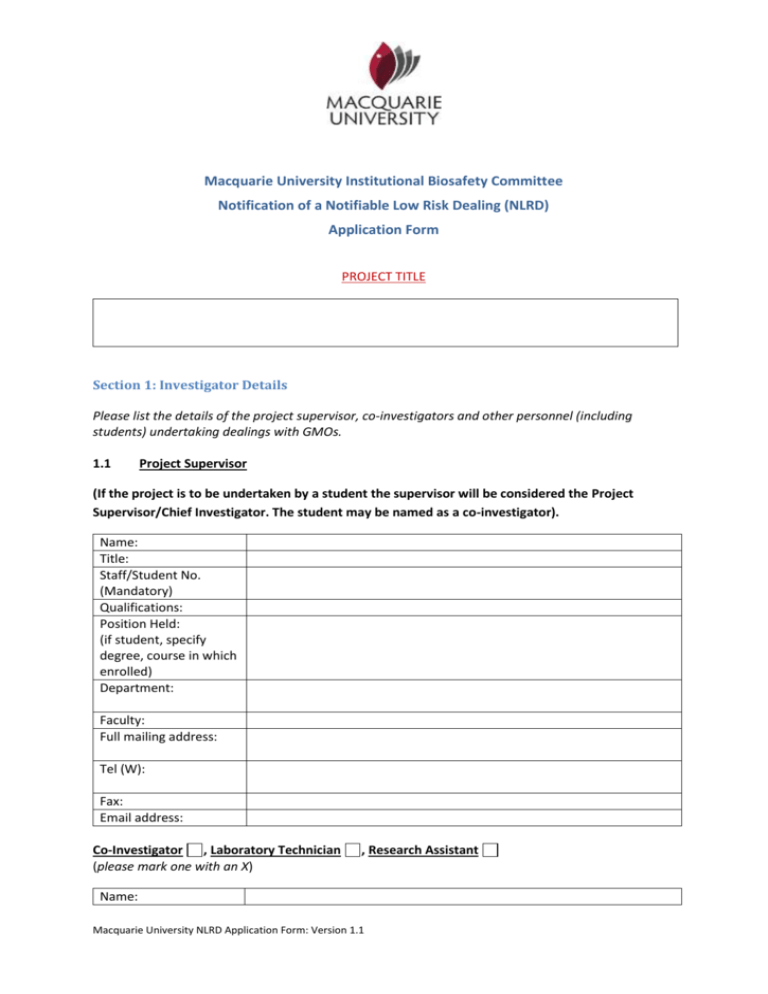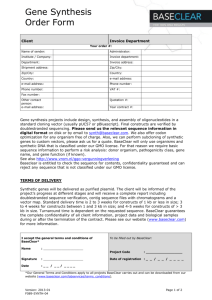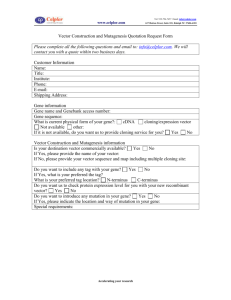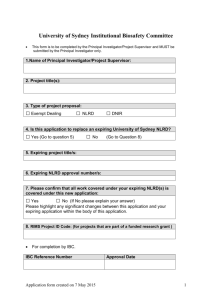doc - Macquarie University
advertisement

Macquarie University Institutional Biosafety Committee Notification of a Notifiable Low Risk Dealing (NLRD) Application Form PROJECT TITLE Section 1: Investigator Details Please list the details of the project supervisor, co-investigators and other personnel (including students) undertaking dealings with GMOs. 1.1 Project Supervisor (If the project is to be undertaken by a student the supervisor will be considered the Project Supervisor/Chief Investigator. The student may be named as a co-investigator). Name: Title: Staff/Student No. (Mandatory) Qualifications: Position Held: (if student, specify degree, course in which enrolled) Department: Faculty: Full mailing address: Tel (W): Fax: Email address: Co-Investigator , Laboratory Technician (please mark one with an X) , Research Assistant Name: Macquarie University NLRD Application Form: Version 1.1 Title: Co-Investigator Type: Staff/Student No. (Mandatory) Qualifications: Position Held: (if student, specify degree, course in which enrolled) Department: Staff OR Student Faculty: Full mailing address: Tel (W): Fax: Email address: PLEASE CUT AND PASTE THIS BOX TO INCLUDE MULTIPLE CO-INVESTIGATORS 1.2(a) Please indicate the proposed date of commencement of the project: DATE: [ / / ] (b) Please indicate the proposed completion date: DATE: [ / / ] (Note: Approval is given for a 5 year period, conditional on the completion of annual progress reports. After 5 years a final report will need to be submitted and a new application will need to be submitted). 1.3(a) Is this a funded project or do you intend to apply for funding? YES NO If you answered YES, please list the funding bodies supporting this project or to which submission is planned: Macquarie University NLRD Application Form: Version 1.1 (b) Funding Status: Approved YES NO Pending YES NO Submitted YES NO If the project has NOT been submitted, please specify the planned date of submission: [ / / ] (c) Please state the title of the project as it appears on your grant application: Please attach the relevant pages of your grant application as it relates to this project for the Committee’s records. (d) Will the study be undertaken if the funding is not successful? YES NO (e) Will the project require a research contract? YES NO If yes, please complete a contracts advice request form, available at: http://www.research.mq.edu.au/for/researchers/how_to_request_a_research_contract/request_fo r_service 1.4(a) Has the project been submitted for approval to the Animal Ethics Committee? YES NO If yes, please indicate the name of the title of the project as it appears on your AEC application: (b) Please provide your reference number, ARA and original date of approval: AEC Ref: ARA: Approval Date: Please note that if the project requires AEC approval then work with GMOs cannot be undertaken without first having obtained AEC approval. Macquarie University NLRD Application Form: Version 1.1 Please contact the Animal Ethics Secretariat if you require further information about AEC approvals: Email: animal.ethics@mq.edu.au Tel: 02 9850 4458 Macquarie University NLRD Application Form: Version 1.1 Section 2: About the dealings with the GMO or GMOs 2.1 Will the dealing involve a direct import of GMOs into Australia? If yes, please provide brief details (please include your permit number if possible): 2.2 Please provide a brief description of the project, including the purpose and aims of the proposed dealing. In preparing your proposal, the OGTR recommends that careful consideration should be given to ensuring that your proposal includes all the activities intending to be undertaken. It should not be so narrow as to preclude foreseeable and intended work (which would then need a separate NLRD) nor so broad or general that it leads to confusion regarding the proposed dealing and what is to be authorised. Macquarie University NLRD Application Form: Version 1.1 Section 3: Types of Notifiable Low Risk Dealing in relation to Schedule 3 (Parts 1 and 2) of the Gene Technology Regulations Please tick the appropriate box/s: Mark Item with X Part 1 – Item 1.1 [Please note that any dealings classified in Part 1 must be undertaken in facilities certified to at least physical containment level 1 (PC1) by the OGTR]. (a) A dealing involving a genetically modified laboratory guinea pig, a genetically modified laboratory mouse, a genetically modified laboratory rabbit or a genetically modified laboratory rat, unless; (i) an advantage is conferred on the animal by the genetic modification; or (ii) the animal is capable of secreting or producing an infectious agent as a result of the genetic modification (c) A dealing involving a replication defective vector derived from Human adenovirus or Adeno associated virus in a host mentioned in item 4 Part 2 of Schedule 2, if the donor nucleic acid: (i) cannot restore replication competence to the vector; and (ii) does not: A confer an oncogenic modification in humans, or; B encode a protein with immunomodulatory activity in humans. Mark Item with X Part 2 – Item 2.1 [Please note that any dealings classified in Part 2 must be undertaken in facilities certified to at least physical containment level 2 (PC2) by the OGTR]. (a) A dealing involving whole animals (including non-vertebrates) that: (i) involves genetic modification of the genome of the oocyte or zygote or early embryo by any means to produce a novel whole organism; and (ii) does not involve any of the following: A. a genetically modified laboratory guinea pig; B. a genetically modified laboratory mouse; C. a genetically modified laboratory rabbit; D. a genetically modified laboratory rat; E. a genetically modified Caenorhabditis elegans; (aa) A dealing involving a genetically modified laboratory guinea pig, a genetically modified laboratory mouse, a genetically modified laboratory rabbit, a genetically modified laboratory rat or a genetically modified Caenorhabditis elegans, if: (i) the genetic modification confers an advantage on the animal; and (ii) the animal is not capable of secreting or producing an infectious agent as a result Macquarie University NLRD Application Form: Version 1.1 of the genetic modification; (b) A dealing involving a genetically modified plant; (c) A dealing involving a host/vector system not mentioned in paragraph 1.1 (c) or Part 2 of Schedule 2, if neither host nor vector has been implicated in, or has a history of causing disease in otherwise healthy: (i)human beings (ii)animals (iii)plants (iv) fungi (d) A dealing involving a host and vector not mentioned as a host/vector system in Part 2 of Schedule 2, if: (i) The host or vector has been implicated in, or has a history of causing desease in otherwise healthy: A. Human beings B. animals C. plants D. fungi; and (ii) the donor nucleic acid is characterised; and (iii) the characterisation of the donor nucleic acid shows that it is unlikely to increase the capacity of the host or vector to cause harm; For example, Donor nucleic acid would not comply with subparagraph (iii) if, in relation to the capacity of the host or vector to cause harm it: a. Provides an advantage b. Adds a potential host species or mode of transmission; or c. Increases its virulence, pathogenicity or transmissibility. (e) A dealing involving a host/vector system mentioned in Part 2 of Schedule 2, if the donor nucleic acid: (i) encodes a pathogenic determinant; or (ii) is uncharacterised nucleic acid from an organism that has been implicated in, or has a history of causing, disease in otherwise healthy A. human beings, B. animals, C. plants or D. fungi; (f) A dealing involving a host/vector system mentioned in Part 2 of Schedule 2 and producing more than 25 litres of GMO culture in each vessel containing the resultant culture, if: (i) the dealing is undertaken in a facility that is certified by the Regulator as a large Macquarie University NLRD Application Form: Version 1.1 scale facility; and (ii) the donor nucleic acid satisfies the conditions set out in subitem 4 (2) of Part 1 of Schedule 2; (g) A dealing involving complementation of knocked-out genes, if the complementation is unlikely to increase the capacity of the GMO to cause harm compared to the capacity of the parent organism before the genes were knocked out; For Example: A dealing would not comply with paragraph (g) if it involved complementation that, in relation to the parent organism: (a) provides an advantage; or (b) adds a potential host species or mode of transmission; or (c) increases its virulence, pathogenicity or transmissibility. (h) A dealing involving shot-gun cloning, or the preparation of a cDNA library, in a host/vector system mentioned in item 1 of Part 2 of Schedule 2, if the donor nucleic acid is derived from either: (i) a pathogen; or (ii) a toxin-producing organism; (i) A dealing involving the introduction of a replication defective viral vector unable to transduce human cells into a host not mentioned in Part 2 of Schedule 2, if the donor nucleic acid cannot restore replication competence to the vector; (j) A dealing involving the introduction of a replication defective non-retroviral vector able to transduce human cells, other than a dealing mentioned in paragraph 1.1 (c), into a host mentioned in Part 2 of Schedule 2, if the donor nucleic acid cannot restore replication competence to the vector; (k) A dealing involving the introduction of a replication defective non-retroviral vector able to transduce human cells into a host not mentioned in Part 2 of Schedule 2, if: (i) the donor nucleic acid cannot restore replication competence to the vector; and (ii) the donor nucleic acid does not: (a) confer an oncogenic modification in humans; or (b) encode a protein with immunomodulatory activity in humans; (l) A dealing involving the introduction of a replication defective retroviral vector able to transduce human cells into a host mentioned in Part 2 of Schedule 2, if: (i) all viral genes have been removed from the retroviral vector so that it cannot replicate or assemble into a virion without these functions being supplied in trans; and (ii) viral genes needed for virion production in the packaging cell line are expressed from independent, unlinked loci with minimal sequence overlap with the vector to limit or prevent recombination; and (iii) either: (a) the retroviral vector includes a deletion in the Long Terminal Repeat sequence Macquarie University NLRD Application Form: Version 1.1 of DNA that prevents transcription of genomic RNA following integration into the host cell DNA; or (b) the packaging cell line and packaging plasmids express only viral genes gagpol, rev and an envelope protein gene, or a subset of these; (m) A dealing involving the introduction of a replication defective retroviral vector able to transduce human cells into a host not mentioned in Part 2 of Schedule 2, if: (i) the donor nucleic acid does not: A. confer an oncogenic modification in humans; or B. encode a protein with immunomodulatory activity in humans; and (ii) all viral genes have been removed from the retroviral vector so that it cannot replicate or assemble into a virion without these functions being supplied in trans; and (iii) viral genes needed for virion production in the packaging cell line are expressed from independent, unlinked loci with minimal sequence overlap with the vector to limit or prevent recombination; and (iv) either: A. the retroviral vector includes a deletion in the Long Terminal Repeat sequence of DNA that prevents transcription of genomic RNA following integration into the host cell DNA; B. the packaging cell line and packaging plasmids express only viral genes gagpol, rev and an envelope protein gene, or a subset of these. or Macquarie University NLRD Application Form: Version 1.1 Section 4: Description of the GMO Please use the table at the end of the application form if using multiple GMOs. 4.1 What are the common and scientific names of the parent organism/s? The ‘parent organism’ means the organism (or tissue derived from an organism) that you propose to genetically modify. Please provide genus and species names. For viruses, please provide the family name. 4.2 What vector/s and methods are to be used for the transfer of genetic material? Please provide copies of references (or vector maps) for novel vectors or methods of transfer. Also include the name of the company supplying any commercially obtained vectors. 4.3 Is the host/vector system listed as an Exempt host/vector system in Schedule 2 Part 2 of the Gene Technology Regulation? YES 4.4 NO If your project involves the use of a replication defective viral vector please provide an explicit description of the assay you intend to perform to exclude the presence of replication competent virus. Please provide a copy of the reference for your intended assay. Your description should include details on the sensitivity of detection. 4.5 What are the identity and function of the gene/s responsible for the modified trait? Please provide information here regarding the gene or genes under study and the function of these gene/s. Please list this information if known. Such functional details are not required about gene/s commonly used as markers, for selection and/or any other routine procedures. However it is necessary to identify generally which type of gene will be used. For example, amp gene (ampicillin resistance, neo gene (neomycin resistance), gfp gene (green fluorescent protein) etc. Macquarie University NLRD Application Form: Version 1.1 4.6 From what organism were the gene/s responsible for the modified trait/s isolated? In regards to gene/s commonly used as markers, for selection and/or any other routine procedures, please indicate the plasmid from which these gene/s were derived. 4.7 What are the organisms or tissues to be used in association with the GMO/s? Please list all the organisms that you intend to use in association with the GMO/s, for example, mice to be inoculated or fed with GMO/s. In this case ‘mouse’ must be listed here. 4.8 How will the materials be disposed? 4.9 Containment Facilities Please provide details of all facilities to be used for this NLRD. Add extra rows if required. Facility No. Room Number and Building Number Facility Type (animal house, laboratory etc) 1 2 3 4 Macquarie University NLRD Application Form: Version 1.1 Physical containment level (eg. PC1, PC2) Section 5: Additional information for a GMO that is a whole plant or is to be used in conjunction with a whole plant Applicable Not Applicable If you answered ‘Applicable’ please complete the following questions. 5.1 To what stage of development are the plants to be grown? This relates to the potential spread of the GMO, for example, if the plant produces pollen or seed. 5.2 What will be used as the growing medium for the plants? Please indicate the type of medium (soil or soil substitute) to be used and how it will be subsequently sterilized or disposed. 5.3 By what means will the materials be disposed? Macquarie University NLRD Application Form: Version 1.1 Table 1 - Examples of responses to Part 4: The description of the GMO(s) The “parent organism” means the organism(s) (or tissue derived from organisms) that you propose to genetically modify and “host” equates to “parent”. 4.1 4.2 4.3 4.5 and 4.6 4.7 Vector(s) and method of transfer Exempt Host/vector system? Identity and function of gene(s) and organism of origin Organisms or tissues to be used with the GMO(s) Common name of parent organism Scientific name of parent organism Mouse Mus musculus Bacterial artificial chromosomes (BACs) microinjected into mouse embryos (knockout IGFII) no IGFII from Macropus eugenii (Tammar Wallaby) none Thale cress Arabidopsis thaliana Non tumorigenic disarmed Ti plasmid via vacuum infiltration. no GFP gene from Aequorea victoria none Human cell line HER911 Transfection with replication deficient adenovirus no EGFR from Mus musculus none NLRD type PC1 (a)-(c) NLRD type PC2 (a)-(m) Macquarie University NLRD Application Form: Version 1.1 a b c Bacteria Enterophathogenic Escherichia coli Standard nonconjugative cloning vector pUC, pBluescript by electroporation no E. coli DNA fragments Mus musculus will be injected with modified bacteria Yeast Saccharomyces cerevisiae Standard yeast expression vector yes CDNA library from Homo sapiens (to investigate cell cycle regulators- potential oncogenes) none Macquarie University NLRD Application Form: Version 1.1 d Exempt Table 1 continued: The Table below can be used to enter your answers – add extra rows if required 4.1 Common name of parent organism Scientific name of parent organism 4.2 4.3 4.5 and 4.6 4.7 Vector(s) and method of transfer Exempt Host/vector system? Identity and function of gene(s) and organism of origin Organisms or tissues to be used with the GMO(s) (must include genus and species name if applicable) Macquarie University NLRD Application Form: Version 1.1 NLRD type PC1 (a)-(c) NLRD type PC2 (a)-(m) Section 6: Declaration and Signatures I declare that to the best of my knowledge, having made reasonable inquiries, the information herein is true and correct. I understand that providing misleading information to the OGTR, deliberately or otherwise, is an offence under Commonwealth law. Project Supervisor Signature: ________________________Date: ______________________________ Printed Name: _______________________________________________________ IBC Chair Signature: ________________________Date: ______________________________ Printed Name: Associate Professor Subramanyam Vemulpad Macquarie University NLRD Application Form: Version 1.1






